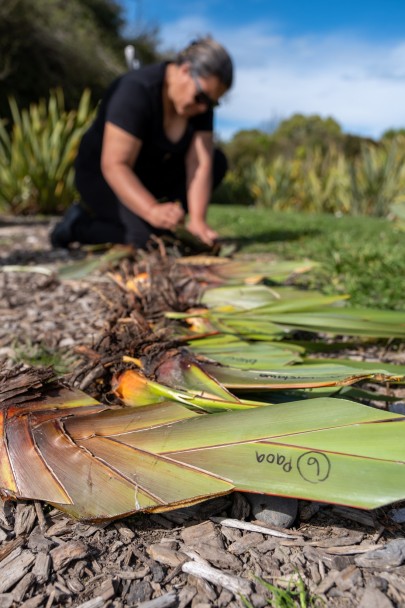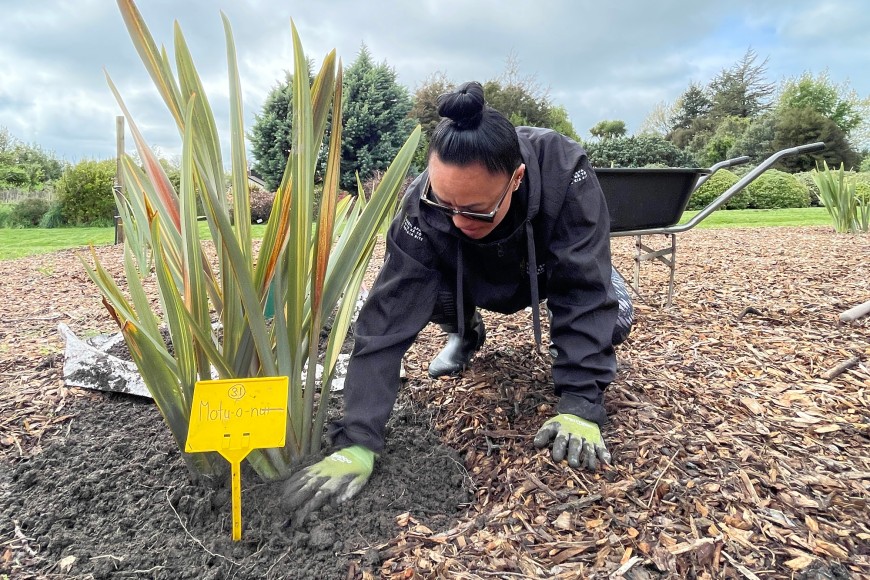
Kuia Sarah Tangitu from Katikati (hapu Te Rereatukahia) selecting harakeke for the Western Bay Museum’s new pā harekeke
“The requests are numerous and various,” says Katarina Tawiri, the kaiwhakahaere/manager of the pā harakeke, a senior technician responsible for our live ethnobotanical plant collections.
Recently, representatives of Ngāti Kuia visited the pā harakeke to dig up 28 harakeke bushes to establish their own pā harakeke at Tītīraukawa, Pelorus Sound. Their pā harakeke is part of a larger project involving a plantation of 60,000 kānuka, and a honey production facility, all situated on iwi land at Tītīraukawa.
“It’s not a one size fits all solution when people ask for harakeke,” says Katarina. After all, the plant’s multiple uses are well-documented. “How is it possible to live there without it?” Māori chiefs of the 18th century asked when they were informed that no flax was growing in England. After food, harakeke (Phormium tenax, New Zealand flax) was one of early Māori communities’ most essential commodities.
It was a plant the early European settlers recognised the value of as well. They quickly set up mills, and in the early 20th century, muka (prepared flax fibre) was AoNZ’s biggest export.
In the mid-20th century, as urbanisation of Māori was encouraged and traditional life on marae was disrupted, many pā harakeke and traditional harakeke cultivars were lost. Rene Orchiston, a skilled Gisborne craftswoman with an interest in natural fibre, noticed the use of inferior material due to the shortage of good-quality harakeke.
She visited weavers and whānau, recording the names and uses of different harakeke she was gifted. Gradually she built up a collection of useful varieties on her farm in Gisborne and in 1987 offered her collection to Manaaki Whenua for safe keeping.
There are 50 different varieties of harakeke in the Rene Orchiston Collection, and they have all been DNA fingerprinted. AoNZ flaxes belong to the family Asphodelaceae, and botanists recognise two species: harakeke, Phormium tenax, found in lowlands and swamps, and wharariki, Phormium cookianum, found in coastal and mountain regions.
While most of the plants in the collection are unique varieties, several groups with identical genetic make-up were identified. These plants are either close kin (originally from the same geographical area or wild population) or vegetative clones (divisions) of the same parent plant.
Māori chose their harakeke depending on its strength, softness, durability, colour, ease of extraction, and quantity of fibre. Favourites were named, and often the name described what the plant was good for, such as the long, orange-edged, slightly droopy, bright-green harakeke makaweroa, meaning ‘long hair’, which can produce long ribbons of soft fibre with the beauty and lustre of silk.
While there are many traditional uses of harakeke, such as clothing, kete, and mats, research is highlighting new uses. PhD student Jaye Barclay from Victoria University is working with Dr Ben Yin and Dr Nancy Garrity on the use of harakeke leaves for membrane filtration of wastewater. Jaye is of Māori and Japanese descent and brings his cultural knowledge and understanding to his work.
But above all, Te Kohinga Harakeke o Aotearoa and Katarina are in increasing demand for the knowledge and resources they offer communities eager set up their own pā harakeke.
Katarina worked with kuia (elder) Kerewai Murray Wanakore and kairaranga (weaver) Sarah Tangitu to choose and harvest seven cultivars that had significance to their iwi as part of an 18-month project to create a pā harakeke at the Western Bay Museum in Katikati, Bay of Plenty.
Darfield High School is also planning to establish its own pā harakeke, with their Year 9 and 10 students acting as kaitiaki. The rural school has an active harakeke weaving programme run by Louise Blakemore who brought the students for a visit to the pā hareke.
Although rain and freezing temperatures meant the students couldn’t be outside, a tractor shed provided some shelter while students were taught how to extract fibre from selected cultivars and how to cut down fans before they can be planted.

Helping to replant harakeke
The job of looking after the pā harakeke also means making sure the plants stay vibrant and healthy. This means every 15 to 20 years a pā harakeke needs to be replanted to rejuvenate the plants. It ensures they grow vigorously and the leaves are long and wide, healthy, disease-free, and able to produce robust new vegetatively propagated plants for distribution to weavers, and leaves for harvesting. Harakeke cultivars do not always grow true from seed, so they must be propagated by root division to ensure the special qualities of the plant are maintained.
The spiritual significance of harakeke was brought home by a request for plants for a particularly poignant reason. In Te Whaiti, near Rotorua, there is a special pā harakeke managed by the Matekuare Whānau Trust, with 10 plants that came from Manaaki Whenua’s pā harakeke. The Matariki Tu Rakau programme’s Phylis Houia Memorial Park is named after a weaver who died young and who was a trustee of the Matekuare Whānau Trust. The plants were planted by the local schoolchildren.
For Katarina, all these community and personal connections to Te Kohinga Harakeke o Aotearoa – National New Zealand Flax Collection reinforce the importance of this special harekeke garden.
